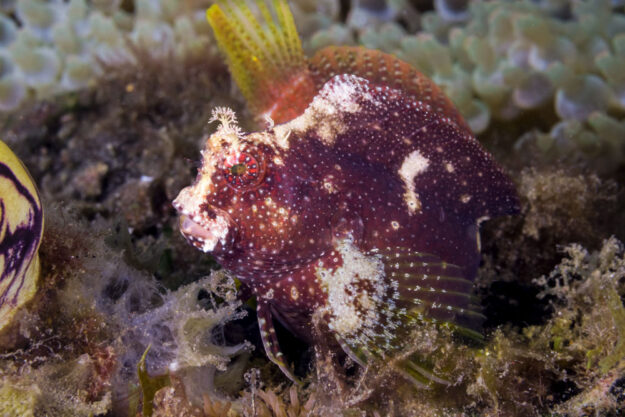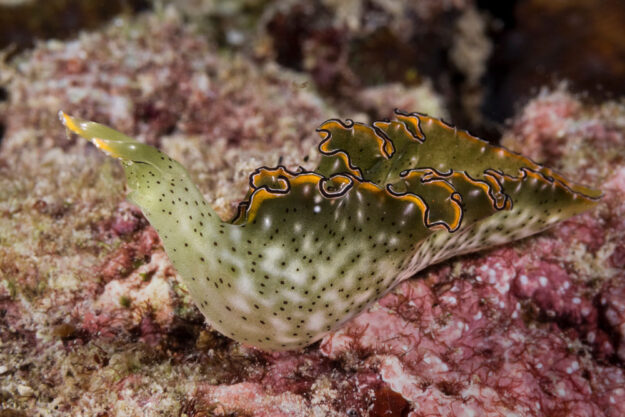Wakatobi’s Vegetarians
A fishy Character
If Dr. Seuss had been a diver, he’d have loved the starry blenny. If you find these colorful little characters perched on acoral or rock outcropping on a Wakatobi dive site, you’ll understand why.

The starry blenny’s feeding habit of scraping bits of algae from the rocks has earned it the nickname starry lawnmower blenny. Photo by Walt Stearns
The spots, the antenna-like stalks that rise above the forehead, the expressive and protruding eyes are all features a cartoonist would appreciate. Add in the seemingly bemused demeanor that is created when this little fish poses with wide mouth agape, and you have a subject worth watching. And chances are, the starry blenny will be watching back, with its eyes moving independently as it scans the reef. These fish will sometimes remain motionless for long periods, holding close to some type of protective cover. Then, suddenly, they may begin flitting about like a hyper preschooler after an overdose of sugar. This ADD-type behavior is characteristic of a number of blennies, but the starry is one of the most enjoyable to watch, as it may also go through a remarkable series of color and pattern changes. When it’s mealtime, the starry blenny uses its comb-shaped teeth to scrape bits of algae from rocks and corals. This feeding pattern has earned it the nickname starry lawnmower blenny.
Saving for a Sunny Day
The name says it all. Sap-sucking sea slugs use their specialized teeth to literally suck the juice out of algae. Most of the time, they simply digest the cellular contents of their fodder, but they also have an ability that is unique in the animal kingdom. Certain shell-less members of the sacoglossa family have the ability to transfer the algae’s living chloroplasts to their own bodies, and keep these photosynthetic compounds alive for periods of weeks and even months.

Sometimes called a lettuce slug, these shell-less snails are true vegans. This green dude resembles a miniature salad wrap. Photo by Walt Stearns
These slug have the ability to activate the stored chloroplasts and literally feed itself off of sunlight. The species that are capable of this feat often have wing-like appendages that spread open to collect more sunlight when they are in solar power mode. The scientists are still scratching their heads over the mechanics of how this simple-seeming slug can perform the complex genetic transfer known as kleptoplasty. What they do know is that the slugs would rather just keep on sucking on the algae, and only reverts to photosynthesis when other food sources dry up. As you’d expect from an animal that enjoys the occasional sunbath, sap-sucking slugs are usually found in relatively shallow water.
These vegetarians are just some of the unique and intriguing creatures you will discover on the reefs of Wakatobi. Many more fascinating stories await, and we hope you will have a chance to meet some of our vegetarians for yourself in the near future.
Contact us at office@wakatobi.com, or complete a quick trip inquiry at wakatobi.com.
Visit us on Facebook and Instagram.
Enjoy our videos on YouTube.


